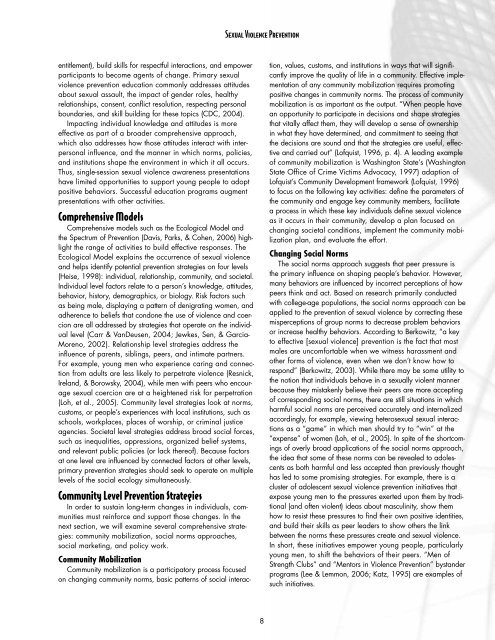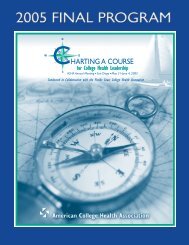<strong>Sexual</strong> <strong>Violence</strong> <strong>Prevention</strong>entitlement), build skills for respectful interactions, and empowerparticipants to become agents <strong>of</strong> change. <strong>Primary</strong> sexualviolence prevention education commonly addresses attitudesabout sexual assault, the impact <strong>of</strong> gender roles, healthyrelationships, consent, conflict resolution, respecting personalboundaries, and skill building for these topics (CDC, 2004).Impacting individual knowledge and attitudes is moreeffective as part <strong>of</strong> a broader comprehensive approach,which also addresses how those attitudes interact with interpersonalinfluence, and the manner in which norms, policies,and institutions shape the environment in which it all occurs.Thus, single-session sexual violence awareness presentationshave limited opportunities to support young people to adoptpositive behaviors. Successful education programs augmentpresentations with other activities.Comprehensive ModelsComprehensive models such as the Ecological Model andthe Spectrum <strong>of</strong> <strong>Prevention</strong> (Davis, Parks, & Cohen, 2006) highlightthe range <strong>of</strong> activities to build effective responses. TheEcological Model explains the occurrence <strong>of</strong> sexual violenceand helps identify potential prevention strategies on four levels(Heise, 1998): individual, relationship, community, and societal.Individual level factors relate to a person’s knowledge, attitudes,behavior, history, demographics, or biology. Risk factors suchas being male, displaying a pattern <strong>of</strong> denigrating women, andadherence to beliefs that condone the use <strong>of</strong> violence and coercionare all addressed by strategies that operate on the individuallevel (Carr & VanDeusen, 2004; Jewkes, Sen, & Garcia-Moreno, 2002). Relationship level strategies address theinfluence <strong>of</strong> parents, siblings, peers, and intimate partners.For example, young men who experience caring and connectionfrom adults are less likely to perpetrate violence (Resnick,Ireland, & Borowsky, 2004), while men with peers who encouragesexual coercion are at a heightened risk for perpetration(Loh, et al., 2005). Community level strategies look at norms,customs, or people’s experiences with local institutions, such asschools, workplaces, places <strong>of</strong> worship, or criminal justiceagencies. Societal level strategies address broad social forces,such as inequalities, oppressions, organized belief systems,and relevant public policies (or lack there<strong>of</strong>). Because factorsat one level are influenced by connected factors at other levels,primary prevention strategies should seek to operate on multiplelevels <strong>of</strong> the social ecology simultaneously.Community Level <strong>Prevention</strong> StrategiesIn order to sustain long-term changes in individuals, communitiesmust reinforce and support those changes. In thenext section, we will examine several comprehensive strategies:community mobilization, social norms approaches,social marketing, and policy work.Community MobilizationCommunity mobilization is a participatory process focusedon changing community norms, basic patterns <strong>of</strong> social interaction,values, customs, and institutions in ways that will significantlyimprove the quality <strong>of</strong> life in a community. Effective implementation<strong>of</strong> any community mobilization requires promotingpositive changes in community norms. The process <strong>of</strong> communitymobilization is as important as the output. “When people havean opportunity to participate in decisions and shape strategiesthat vitally affect them, they will develop a sense <strong>of</strong> ownershipin what they have determined, and commitment to seeing thatthe decisions are sound and that the strategies are useful, effectiveand carried out” (L<strong>of</strong>quist, 1996, p. 4). A leading example<strong>of</strong> community mobilization is Washington State’s (WashingtonState Office <strong>of</strong> Crime Victims Advocacy, 1997) adaption <strong>of</strong>L<strong>of</strong>quist’s Community Development framework (L<strong>of</strong>quist, 1996)to focus on the following key activities: define the parameters <strong>of</strong>the community and engage key community members, facilitatea process in which these key individuals define sexual violenceas it occurs in their community, develop a plan focused onchanging societal conditions, implement the community mobilizationplan, and evaluate the effort.Changing Social NormsThe social norms approach suggests that peer pressure isthe primary influence on shaping people’s behavior. However,many behaviors are influenced by incorrect perceptions <strong>of</strong> howpeers think and act. Based on research primarily conductedwith college-age populations, the social norms approach can beapplied to the prevention <strong>of</strong> sexual violence by correcting thesemisperceptions <strong>of</strong> group norms to decrease problem behaviorsor increase healthy behaviors. According to Berkowitz, “a keyto effective [sexual violence] prevention is the fact that mostmales are uncomfortable when we witness harassment andother forms <strong>of</strong> violence, even when we don’t know how torespond” (Berkowitz, 2003). While there may be some utility tothe notion that individuals behave in a sexually violent mannerbecause they mistakenly believe their peers are more accepting<strong>of</strong> corresponding social norms, there are still situations in whichharmful social norms are perceived accurately and internalizedaccordingly, for example, viewing heterosexual sexual interactionsas a “game” in which men should try to “win” at the“expense” <strong>of</strong> women (Loh, et al., 2005). In spite <strong>of</strong> the shortcomings<strong>of</strong> overly broad applications <strong>of</strong> the social norms approach,the idea that some <strong>of</strong> these norms can be revealed to adolescentsas both harmful and less accepted than previously thoughthas led to some promising strategies. For example, there is acluster <strong>of</strong> adolescent sexual violence prevention initiatives thatexpose young men to the pressures exerted upon them by traditional(and <strong>of</strong>ten violent) ideas about masculinity, show themhow to resist these pressures to find their own positive identities,and build their skills as peer leaders to show others the linkbetween the norms these pressures create and sexual violence.In short, these initiatives empower young people, particularlyyoung men, to shift the behaviors <strong>of</strong> their peers. “Men <strong>of</strong>Strength Clubs” and “Mentors in <strong>Violence</strong> <strong>Prevention</strong>” bystanderprograms (Lee & Lemmon, 2006; Katz, 1995) are examples <strong>of</strong>such initiatives.8
<strong>Sexual</strong> <strong>Violence</strong> <strong>Prevention</strong>Social MarketingSocial marketing campaigns draw upon marketing researchand behavior change theory to develop strategies to shiftbehaviors. Key components include orientating the campaigntoward a target audience, conducting formative research andpre-testing <strong>of</strong> messages, developing strategies to address barriersand competition to adapting new behaviors, and using astandard marketing mix (product, price, place, and promotion)(Lefebre & Flora, 1988). California’s MyStrength Campaignuses peer-to-peer contact to create new social norms reinforcedby a supportive school environment, paid advertising, andearned media. The campaign theme “My Strength Is Not forHurting” repositions the concept <strong>of</strong> male strength to encourage,motivate, and enable young men to take action to preventsexual violence (Lee & Lemmon, 2006).Policy to Promote <strong>Primary</strong> <strong>Prevention</strong>The implementation <strong>of</strong> education and social norms changingactivities, and other pieces <strong>of</strong> a comprehensive strategy againstsexual violence among youth, requires ongoing support fromkey decision-makers in the community, and in state and federalorganizations. The Ecological Model places policy activities atthe societal level, influencing factors such as gender-equalityand social norms. Establishing polices that mandate universitystaff respond to sexual harassment and changing advertisingpractices that sexualize or objectify women are examples <strong>of</strong>potential policies.The Future <strong>of</strong> <strong>Sexual</strong> <strong>Violence</strong> <strong>Prevention</strong>Whether or not we see a future decrease in the prevalence<strong>of</strong> sexual violence will hinge on how effective today’s effortsare with adolescents. By engaging young people to be part <strong>of</strong>the solution, a new generation <strong>of</strong> leaders will be empoweredto further prevention efforts.<strong>Sexual</strong> violence prevention efforts are in the midst <strong>of</strong> a transitionfrom creating awareness <strong>of</strong> sexual violence to advancingcomprehensive primary prevention strategies for communitychange. Since sexual violence is a cultural issue, solutions mustgo beyond stopping sexual violence, and should promotebehaviors and cultural norms that are healthy, such as egalitariangender roles, gender equity, healthy relationships, andhealthy sexuality. Both women and men must be engaged in thiseffort to create the day when sexual violence no longer exists sothat we can, “… begin the real practice <strong>of</strong> equality, and then,instead <strong>of</strong> rape we will for the first time in our lives — both menand women — begin to experience freedom” (Dworkin, 1983).David S. Lee, MPH, is <strong>Prevention</strong> Director at the CaliforniaCoalition Against <strong>Sexual</strong> Assault. Lydia Guy, BA, is <strong>Prevention</strong>Services Director for the Washington Coalition <strong>of</strong> <strong>Sexual</strong> AssaultPrograms. Brad Perry, MA, is the <strong>Sexual</strong> <strong>Violence</strong> <strong>Prevention</strong>Coordinator at the Virginia <strong>Sexual</strong> and Domestic <strong>Violence</strong>Action Alliance.This article has been adapted from D. S. Lee, L. Guy, B. Perry,C. K. Sniffen, S. A. Mixson, (2007) <strong>Sexual</strong> <strong>Violence</strong> <strong>Prevention</strong>,The <strong>Prevention</strong> Researcher, Volume 14(2), pp. 15-20.ReferencesBanyard, V.L., Plante, E.G., & Moynihan, M.M. (2004). Bystander education: Bringing abroader community perspective to sexual violence prevention. Journal <strong>of</strong> Community Psychology,32, 61-79.Berkowitz, A. (2003). Young Men as Allies in Preventing <strong>Violence</strong> and Abuse — BuildingEffective Partnerships with Schools, Family <strong>Violence</strong> <strong>Prevention</strong> Fund’s 2003 Online DiscussionSeries: “Building Partnerships to End Men’s <strong>Violence</strong>” — Discussion 4, Retrieved November2006, www.vawnet.org/Domestic<strong>Violence</strong>/<strong>Prevention</strong>AndEducation/Approaches/SocialNorms.phpBuchwald, E. et. al. (1993). Transforming a Rape Culture. Minneapolis, MN: Milkweed Editions.Carr, J.L., & VanDeusen, K.M. (2004). Risk factors for male sexual aggression on collegecampuses. Journal <strong>of</strong> Family <strong>Violence</strong>, 19(5), 179-189.Centers for Disease Control and <strong>Prevention</strong>. (2004). <strong>Sexual</strong> <strong>Violence</strong> <strong>Prevention</strong>: Beginning theDialogue, Atlanta, GA: Centers for Disease Control and <strong>Prevention</strong>.Clinton-Sherrod, M., Gibbs, D., Amy Vincus, A., Squire, S., Cignetti, C., Pettibone, K, & Igoe, J.(2003). Report Describing Projects Designed to Prevent First-Time Male Perpetration <strong>of</strong> <strong>Sexual</strong><strong>Violence</strong>. Retreived from www.nsvrc.org/resources/docs/rti_report.pdfDavis, R. Parks, L. F., & Cohen, L. (2006). <strong>Sexual</strong> <strong>Violence</strong> and the Spectrum <strong>of</strong> <strong>Prevention</strong>,Enola, PA: National <strong>Sexual</strong> <strong>Violence</strong> Resource Center.Dworkin, A. (1983). I Want a Twenty-Four-Hour Truce During Which There Is No Rape. In A.Dworkin (1989) Letters From a War Zone: Writings 1976-87. New York: E. P. Dutton. RetrievedNovember 2006 from www.nostatusquo.com/ACLU/dworkin/WarZoneChaptIIIE.htmlHeise, L. (1998). <strong>Violence</strong> against women: An integrated, ecological framework. <strong>Violence</strong>Against Women, 4(3), 262-290.hooks, b. (1989) Talking back: thinking feminist, thinking black. Boston, MA: South End Press.Jewkes, R., Sen, P., & Garcia-Moreno, C. (2002). <strong>Sexual</strong> violence. In E. G. Krug, L.L. Dahlberg,J.A. Mercy, A.B. Zwi & R. Lozano (Eds.), World Report on <strong>Violence</strong> and <strong>Health</strong> (pp. 147-181).Geneva: World <strong>Health</strong> Organization.Katz, J. (1995) Reconstructing masculinity in the locker room: The Mentors in <strong>Violence</strong><strong>Prevention</strong> Project. Harvard Educational Review, Vol. 65, No. 2.Lee, D.S., & Lemmon, P. (November 2006). MyStrength: California’s social marketing campaignto engage young men to prevent sexual violence Poster session presented at the annual meeting<strong>of</strong> the <strong>American</strong> Public <strong>Health</strong> Association, Boston, MA.Lefebre R.C., & Flora, J. A. (1988). Social Marketing and Public <strong>Health</strong>. <strong>Health</strong> EducationQuarterly Vol. 15 (3), 299-315.L<strong>of</strong>quist, W. (1996). Technology <strong>of</strong> Development. Development Publications.Loh, C., Gidycz, C.A., Lobo, T.R., & Luthra, R. (2005). A prospective analysis <strong>of</strong> sexual assaultperpetration: Risk factors related to perpetrator characteristics. Journal <strong>of</strong> Interpersonal <strong>Violence</strong>,20, 1325-1348.Morrison, S., Hardison, J., Mathew, A., & O’Neil, J. (September 2004). An Evidence-BasedReview <strong>of</strong> <strong>Sexual</strong> Assault Preventive Intervention Programs. Retrieved on November 30, 2006from www.ncjrs.gov/pdffiles1/nij/grants/207262.pdfNational Center for Injury <strong>Prevention</strong> and Control. (2006, September 7). <strong>Sexual</strong> <strong>Violence</strong>:Fact sheet. Retrieved November, 2006, from www.cdc.gov/ncipc/factsheets/svfacts.htmResnick, M.D., Ireland, M., & Borowsky, I. (2004). Youth violence perpetration: What protects?What predicts? Findings from the National Longitudinal Study <strong>of</strong> Adolescent <strong>Health</strong>. Journal <strong>of</strong>Adolescent <strong>Health</strong>, 35, 424-433.Rozee, P.D., & Koss, M. P. (2001). Rape: A century <strong>of</strong> resistance, Psychology <strong>of</strong> WomenQuarterly, 25, 295-311.Washington State Office <strong>of</strong> Crime Victims Advocacy, (August 1997). <strong>Sexual</strong> Assault <strong>Prevention</strong>Plan for Washington State. Office <strong>of</strong> Crime Victims Advocacy, Department <strong>of</strong> Community,Trade and Economic Development and Washington State Department <strong>of</strong> <strong>Health</strong>, The EvergreenState <strong>College</strong>.9



![Final Program [5.4MB pdf] - American College Health Association](https://img.yumpu.com/49022356/1/190x245/final-program-54mb-pdf-american-college-health-association.jpg?quality=85)












